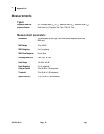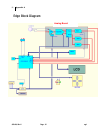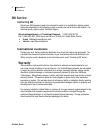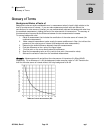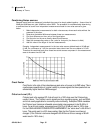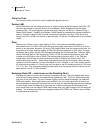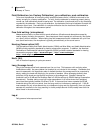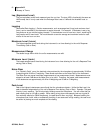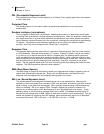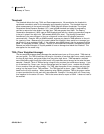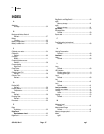
60 Appendix B
Glossary of Terms
053-644, Rev H Page 60 eg4
Criterion Time
The time over which the Criterion Level is established, generally 8 hours.
Decibel (dB)
Sound Level Meters use the decibel as the unit of measure known as Sound Pressure Level (SPL). SPL
uses the ratio between a reference level of 20 microPascals (.00002 Pascals) and the level being
measured. SPL = 20 log (measured level/reference level). Example: the SPL for 1 Pascal is 20 log (1
Pascal/.00002 Pascal) = 94dB 20 microPascals (.00002 Pascals) is considered the average threshold of
hearing. A whisper is about 20 dB. A normal conversation is typically from 60 to 70 dB, and a noisy
factory from 90 to 100 dB. Loud thunder is approximately 110 dB, and 120 dB borders on the threshold
of pain.
Dose
Related to the Criterion Level, a dose reading of 100% is the maximum allowable exposure to
accumulated noise. For OSHA, 100% dose occurs for an average sound level of 90 dB over an 8 hour
period (or any equivalent exposure). By using a TWA reading rather than the average sound level, the
time period is no longer explicitly needed. A TWA of 90 dB is the equivalent of 100% dose. The dose
will double (halve) every time the TWA increases (decreases) by the Exchange Rate. Example: OSHA
uses an Exchange Rate of 5 dB. Suppose the TWA is 100 dB. The dose would double for each 5 dB
increase over the Criterion Level of 90 dB. The resulting dose is therefore 400%. If the TWA was
instead equal to 80 dB then the dose would halve for each 5 dB below the Criterion Level. The
resulting dose would be 25%. When taking noise samples less that the full workday, dose is an easy
number to work with because it is linear with respect to time. Example: If a 0.5-hour sample results in
9% dose and the workday is 7.5 hours long, then the dose for the full workday would be a 135% dose
(7.5 / 0.5 x 9%). This is computed making the assumption that the sampled noise will continue at the
same levels for the full 7.5-hour workday.
Exchange Rate (ER – also known as the Doubling Rate)
Exchange rate refers to how the sound energy is averaged over time. Using the decibel scale, every
time the sound energy doubles, the measured level increases by 3dB. This is the 3dB exchange rate
that most of the world uses. For every increase of 3dB in the time weighted average, the measured
DOSE would double. Some organizations such as OSHA in the U.S. have argued that the human ear
self compensates for changing noise levels and they felt that the 3dB exchange rate should be changed
to more closely match the response of the human ear. OSHA currently uses a 5dB exchange rate,
which would mean that the reported DOSE would double with every 5dB increase in the time weighted
average. The exchange rate affects the integrated reading LAVG, DOSE, and TWA but does not affect
the instantaneous sound level.



